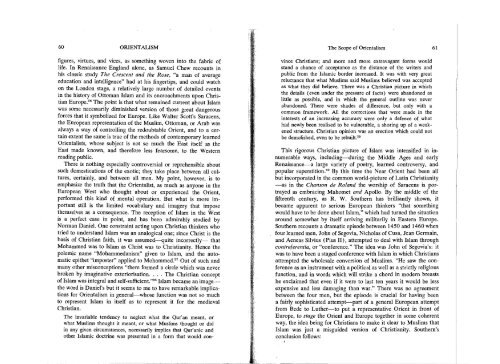Orientalism - autonomous learning
Orientalism - autonomous learning
Orientalism - autonomous learning
You also want an ePaper? Increase the reach of your titles
YUMPU automatically turns print PDFs into web optimized ePapers that Google loves.
60 ORIENTALISM<br />
The Scope of <strong>Orientalism</strong><br />
61<br />
figures, virtues, and vices, as something woven into the fabric of<br />
life. In Renaissance England alone, as Samuel Chew recounts in<br />
his classic study The Crescent and the Rose, "a man of average<br />
education and intelligence" had at his fingertips, and could watch<br />
on the London stage, a relatively large number of detailed events<br />
in the history of Ottoman Islam and its encroachments upon Christian<br />
Europe. 36 The point is that what remained current about Islam<br />
was some necessarily diminished version of those great dangerous<br />
forces that it symbolized for Europe. Like Walter Scott's Saracens,<br />
the European representation of the Muslim, Ottoman, or Arab was<br />
always a way of controlling the redoubtable Orient, and to a certain<br />
extent the same is true of the methods of contemporary learned<br />
Orientalists, whose subject is not so much the East itself as the<br />
East made known, and therefore less fearsome, to the Western<br />
reading public.<br />
There is nothing especially controversial or reprehensible about<br />
such domestications of the exotic; they take place between all cultures,<br />
certainly, and between all men. My point, however, is to<br />
emphasize the truth that the Orientalist, as much as anyone in the<br />
European West who thought about or experienced the Orient,<br />
perfonned this kind of mental operation. But what is more important<br />
still is the limited vocabulary and imagery that impose<br />
themselves as a consequence. The reception of Islam in the West<br />
is a perfect case in point, and has been admirably studied by<br />
Norman Daniel. One constraint acting upon Christian thinkers who<br />
tried to understand Islam was an analogical one; since Christ is the<br />
basis of Christian faith, it was assumed-quite incorrectly- that<br />
Mohammed was to Islam as Christ was to Christianity. Hence the<br />
polemic name "Mohammedanism" given to Islam, and the automatic<br />
epithet "imposter" applied to Mohammed. 37 Out of such and<br />
many other misconceptions "there formed a circle which was never<br />
broken by imaginative exteriorisation. . . . The Christian concept<br />
of Islam was integral and self-sufficient."38 Islam became an imagethe<br />
word is Daniel's but it seems to me to have remarkable implications<br />
for <strong>Orientalism</strong> in general-whose function was not so much<br />
to represent Islam in itself as to .represent it for the medieval<br />
Christian.<br />
The invariable tendency to neglect what the Our'an meant, or<br />
what Muslims thought it meant, or what Muslims thought or did<br />
in any given circumstances, necessarily implies that Our'anic and<br />
other Islamic doctrine was presented in a form that would con-<br />
vince Christians; and more and more extravagant forms would<br />
stand a chance of acceptance as the distance of the writers and<br />
public from the Islamic border increased. It was with very great<br />
reluctance that what Muslims said Muslims believed was accepted<br />
as what they did believe. There was a Christian picture in which<br />
the details (even under the pressure of facts) were abandoned as<br />
little as possible, and in which the general outline was never<br />
abandoned. There were shades of difference, but only with a<br />
common framework. All the corrections that were made in the<br />
interests of an increasing accuracy were only a. defence of what<br />
had newly been realised to be vulnerable, a shoring up of a weakened<br />
structure. Christian opinion was an erection which could not<br />
be demolished, even to be rebuilt. 39<br />
This rigorous Christian picture of Islam was intensified in innumerable<br />
ways, including-during the Middle Ages and early<br />
Renaissance-a large variety of poetry, learned controversy, and<br />
popular superstition. 40 By this time the Near Orient had been all<br />
but incorporated in the common world-picture of Latin Christianity<br />
-as in the Chanson de Roland the worship of Saracens is portrayed<br />
as embracing Mahomet and Apollo. By the middle of the<br />
fifteenth century, as R. W. Southern has brilliantly shown, it<br />
became apparent to serious European thinkers "that something<br />
would have to be done about Islam," which had turned the situation<br />
around somewhat by itself arriving militarily in Eastern Europe.<br />
Southern recounts a dramatic episode between 1450 and 1460 when<br />
four learned men, John of Segovia, Nicholas of Cusa, Jean Germain,<br />
and Aeneas Silvius (Pius II), attempted to deal with Islam through<br />
contraferentia, or "conference." The idea was John of Segovia's: it<br />
was to have been a staged conference with Islam in which Christians<br />
attempted the wholesale conversion of Muslims. "He saw the conference<br />
as an instrument with a political as well as a strictly religious<br />
function, and in words which will strike a chord in modern breasts<br />
he exclaimed that even if it were to last ten years it would be less<br />
expensive and less damaging than war." There was no agreement<br />
between the four men, but the episode is crucial for having been<br />
a fairly sophisticated attempt-part of a general European attempt<br />
from Bede to Luther-to put a representative Orient in front of<br />
Europe, to stage the Orient and Europe together in some coherent<br />
way, the idea being for Christians to make it clear to Muslims that<br />
Islam was just a misguided version of Christianity. Southern's<br />
conclusion follows:
















